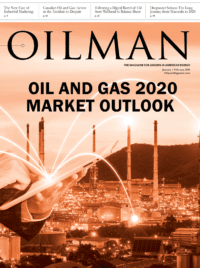We all want to possess the ability to predict the future. This is something we covered in a previous feature article on artificial intelligence and it applies here, but in a slightly different way. The start of a new year brings new things, a little of the unexpected. The unknown brings with it some apprehension because when you’re talking about oil and gas outlooks, you’re talking about someone’s livelihood. From the CEO of a company, to the operators and everyone above, below and in between – no person, company or place is immune from the effects of a volatile oil and gas market.
In these circumstances, we’d all like a fortune teller. Someone to ease our mind and to provide us with some insightful information to help arm ourselves as to what to expect in the new year. Duane Dickson, Vice Chairman of Deloitte Consulting LLP’s Energy Resources and Industrials industry group is doing just that. He is the author of Deloitte’s 2020 Oil, Gas, and Chemical Industry Outlook and his knowledge is instrumental to educating the public in the industry’s potential path forward.
“As we once again, move from one year to the next, how do we assess the oil and gas and chemical sectors’ performance in 2019 and its prospects for 2020? As always, there are headwinds and tailwinds, risks and opportunities, uncertainties and foreseeable trends, but in this report we aim to take stock of the main factors to watch for in 2020 across the diverse oil, gas, and chemical industry. Over the past decade, we have seen the heights of bullish optimism and seemingly limitless investment during the years of the $100 barrel world, from 2011 to mid-2014, and the lows of the price crash and extended oil downturn, from mid- 2014-2017. Neither extreme seems in the cards for an imminent return as the industry has learned valuable lessons from both episodes, but uncertainties are clearly still a challenge to performance and investment,” Dickson says.
In this feature, we will only be exploring Deloitte’s oil and gas sector, as it applies to OILMAN Magazine. The oil and gas sector of the 2020 outlook is broken down into five parts:
Market Fundamentals: Trade and Economic Headwinds are Causing Uncertainty for Fuel Markets
“Deloitte forecasts that U.S. GDP growth will slow in 2020, with a 25 percent chance of recession and only 10 percent chance that growth in 2020 will match recent years,” Dickson said. There are a number of countries facing economic headwinds, so globally, the picture is not much different. There are regulatory changes, such as IMO2020 (International Maritime Organization) – a new regulation that will be implemented for a 0.50 percent global sulphur cap for marine fuels in an effort to reduce the amount of sulphur oxide. This is a drastic change from the previous 3.5 percent and could lead to near-term changes in product demand, changing the types of crude needed to meet the potential rapid increase in marine gasoil to meet the lower-sulfur fuel requirements.
In addition, if production from the Permian moderates in 2020, and that is uncertain, it would make OPEC’s job easier. The mid-2019 OPEC and non-OPEC country (e.g., Russia) agreement cuts targets by 1.2 million bpd, but global oil and fuels stocks rose in 2018 and 2019. Lower shale output along with OPEC’s quotas could bring the market in balance in 2020 and act as a cushion against weakening prices.
Global Oil Supply: Increasing Security and Decreasing Demand of Global Oil Supply
In September 2019, an attack on critical facilities in Saudi Arabia resulted in the largest single supply disruption since the Gulf War in 1991. Despite this, market disruption was largely avoided. The global market has seen the slower-moving decline of supply from two other major producers – Iran and Venezuela. Iran because of economic sanctions and Venezuela because of both economic sanctions and the ongoing degradation of investment and operating conditions in the Venezuelan oil sector. This begs the question of whether or not security of supply should be a bigger concern in 2020.
There are a number of factors that could reduce supply risk in the current market environment:
- Growing supply from Western Hemisphere producers – United States and Brazil are both delivering growth in supply barrels from onshore shale plays and deepwater plays.
- Healthy commercial crude oil inventories in OECD (Organization of Economic Cooperation and Development where 36 member countries and partners span the globe and work together to promote economic growth, prosperity and sustainable development).
- The production restraint agreement between the OPEC and non-OPEC Vienna agreement countries is still in place, preserving spare production capacity.
“If we also assume that a lower-demand growth outlook is quite possible in 2020, as a result of potentially weakening global economies, then we could conclude that supply security is reasonably robust, even in the face of security risks in some key producing countries,” says Dickson.
Liquid Natural Gas: LNG Volumes are Up, but Sanctioning New Projects will be Hard
The U.S. LNG export growth exceeded five billion cubic feet per day for the first time in 2019 and it has not stopped growing yet, and once the current projects under construction are completed and fully ramped up, export capacity could hit 10 billion cubic feet per day by 2021. European and Asian prices are a decade lows, Henry Hub prices remain even lower, supporting the competitiveness of U.S. LNG exports into a soft global gas market. This has cut into profits for existing exporters, but it poses a bigger challenge for project developers looking to sanction in 2020.
Historically, the U.S. LNG projects’ value proposition has been based on three things:
- Access to a highly liquid and interconnected low-price natural gas market.
- Contracts with flexible destination and multiple pricing mechanisms.
- Lower, less volatile delivered costs than many competing oil-indexed projects have built in recent years.
The U.S. gas market remains a key strength for domestic developers with competitors willing to provide flexibility in a buyer’s market. With tariffs and low oil prices, U.S. cargo pricing is not as attractive as it once was. A number of projects were sanctioned in 2019, both in the U.S. and internationally, but most were brownfield or sold without long-term offtake contracts. This is, however, not an option for greenfield developers relying on project financing.
“Finding anchor buyers is 2020 is expected to be key. The global gas markets are soft today but could tighten in the next few years and new projects will be sanctioned to meet future demand,” says Dickson.
Financial Markets: Oil and Gas Investors are Expecting Increased Efficiencies Despite Slowdown
Gains in well productivity are slowing down in shale plays and because of fears of global economic shutdown, it is likely that 2020 will be another challenging year for the industry financially. A practical financial management strategy driven by operational and technological leadership could be key to retain or win back investors’ trust. Many companies have made excellent progress in this area, however financial markets are still holding back to see if prudent financial performance can be sustained.
It’s anticipated that investors will be closely watching how shale operators improve their capital efficiency, which through optimal completion designs, can be enhanced by about 20-25 percent in key shale basins. Investors will also likely pay attention to how the associated subsectors, primarily oilfield services and infrastructure providers, can help operators bring new efficiencies and save costs without compromising their margins and sustainability.
“The display of operational leadership by oil and gas companies and the patience of investors in finding and investing in these companies can turn out to be a huge opportunity for both in 2020. Everyone wins when the focus is on operational excellence and financial discipline,” says Dickson.
Emerging Longer-term Disruptive Trends: The Energy Transition is Gaining Momentum in the Oil and Gas Sector
The energy transition poses new challenges for oil and gas companies and could prove disruptive to long-standing market structures, value chains, customer preferences, and the economic drivers for the oil and gas business. The challenge of these companies is that they will need to figure out how to produce more oil and gas (and increasingly power) year after year while also being carbon-conscious and addressing stakeholders’ sustainability concerns.
There are at least four concrete steps that companies can take in the near term:
- Low hanging fruit should be identified for reducing greenhouse gas emissions like eliminating methane links from existing infrastructure.
- Deploy renewables to reduce emissions from field operations.
- CO2 enhanced oil recovery could be an avenue to boost production while sequestering carbon.
- Invest in the infrastructure to sustain operations – especially in regard to water use and wastewater disposal.
Dickson says, “The energy transition is a long-term trend, but we have seen a greater focus on this in 2019, which we expect to gain momentum in 2020. Decisions made now can help companies better position themselves for the decades ahead, to thrive by anticipating disruptive change rather than reacting to it too late.”
Conclusion
In this outlook, we see some trends and suggestions that apply to concepts that we’ve covered in OILMAN over the last year. Artificial intelligence and drone technologies are reoccurring solutions that continue to emerge when talking about preemptive strategies for efficiency and problem solving within oil and gas companies. It’s an evolving industry and one that will always be faced with headwinds. Everyone is affected in some way by the ups and downs of the oil and gas sector. As long as we all, as a uniform industry, stay abreast of the subject matter needs and work to constantly evolve and embrace change that will help improve upon operations, we’ll continue to thrive.
To read Duane Dickson’s Deloitte “2020 Oil, Gas, and Chemical Industry Outlook” in its entirety, please visit Deloitte to review.
Sarah Skinner is a graduate of Louisiana State University with a degree in English. She has been a technical writer and editor in the oil and gas industry for over ten years in Houston and in Louisiana. She currently works as a technical writer for a pre-cast concrete construction company in Louisiana that builds blast-proof buildings for petrochemical plants.







